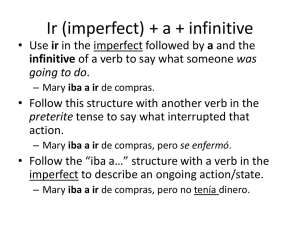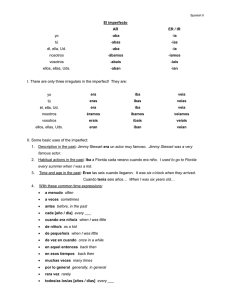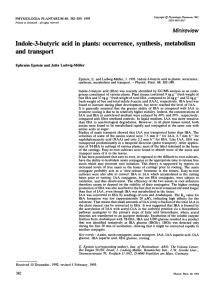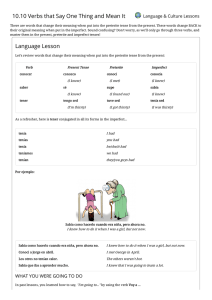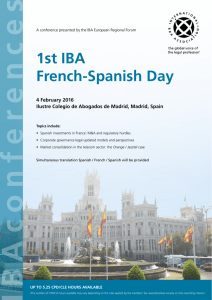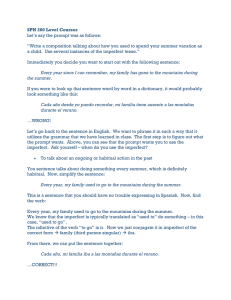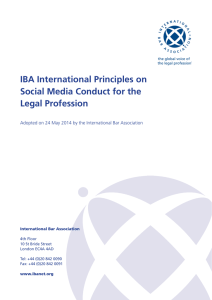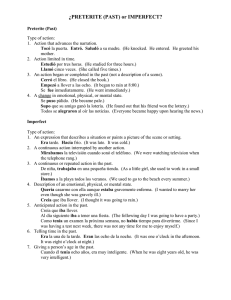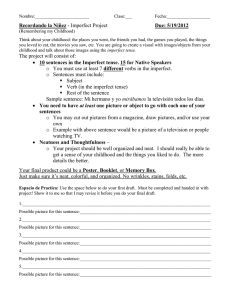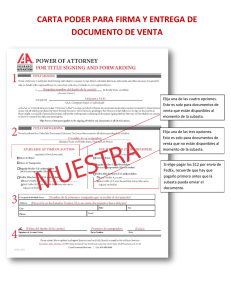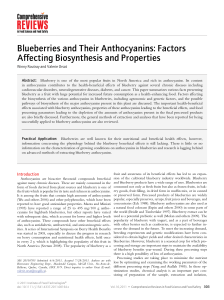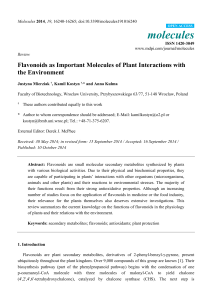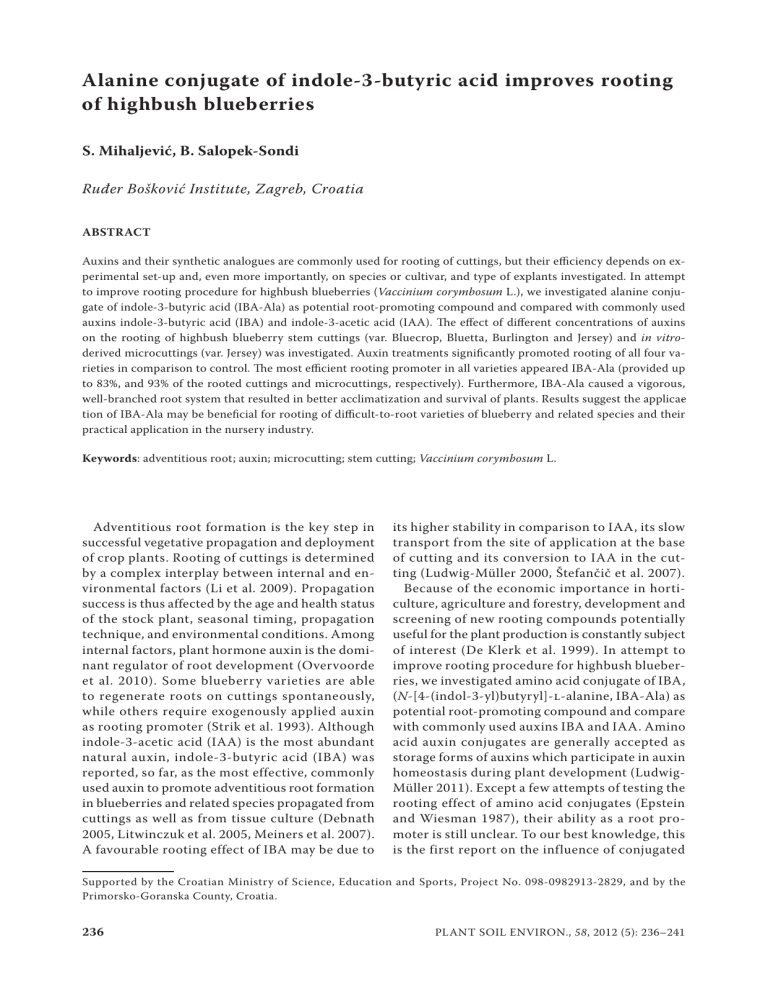
Alanine conjugate of indole-3-butyric acid improves rooting of highbush blueberries S. Mihaljević, B. Salopek-Sondi Ruđer Bošković Institute, Zagreb, Croatia ABSTRACT Auxins and their synthetic analogues are commonly used for rooting of cuttings, but their efficiency depends on experimental set-up and, even more importantly, on species or cultivar, and type of explants investigated. In attempt to improve rooting procedure for highbush blueberries (Vaccinium corymbosum L.), we investigated alanine conjugate of indole-3-butyric acid (IBA-Ala) as potential root-promoting compound and compared with commonly used auxins indole-3-butyric acid (IBA) and indole-3-acetic acid (IAA). The effect of different concentrations of auxins on the rooting of highbush blueberry stem cuttings (var. Bluecrop, Bluetta, Burlington and Jersey) and in vitroderived microcuttings (var. Jersey) was investigated. Auxin treatments significantly promoted rooting of all four varieties in comparison to control. The most efficient rooting promoter in all varieties appeared IBA-Ala (provided up to 83%, and 93% of the rooted cuttings and microcuttings, respectively). Furthermore, IBA-Ala caused a vigorous, well-branched root system that resulted in better acclimatization and survival of plants. Results suggest the applica�tion of IBA-Ala may be beneficial for rooting of difficult-to-root varieties of blueberry and related species and their practical application in the nursery industry. Keywords: adventitious root; auxin; microcutting; stem cutting; Vaccinium corymbosum L. Adventitious root formation is the key step in successful vegetative propagation and deployment of crop plants. Rooting of cuttings is determined by a complex interplay between internal and environmental factors (Li et al. 2009). Propagation success is thus affected by the age and health status of the stock plant, seasonal timing, propagation technique, and environmental conditions. Among internal factors, plant hormone auxin is the dominant regulator of root development (Overvoorde et al. 2010). Some blueberry varieties are able to regenerate roots on cuttings spontaneously, while others require exogenously applied auxin as rooting promoter (Strik et al. 1993). Although indole-3-acetic acid (IAA) is the most abundant natural auxin, indole-3-butyric acid (IBA) was reported, so far, as the most effective, commonly used auxin to promote adventitious root formation in blueberries and related species propagated from cuttings as well as from tissue culture (Debnath 2005, Litwinczuk et al. 2005, Meiners et al. 2007). A favourable rooting effect of IBA may be due to its higher stability in comparison to IAA, its slow transport from the site of application at the base of cutting and its conversion to IAA in the cutting (Ludwig-Müller 2000, Štefančič et al. 2007). Because of the economic importance in horticulture, agriculture and forestry, development and screening of new rooting compounds potentially useful for the plant production is constantly subject of interest (De Klerk et al. 1999). In attempt to improve rooting procedure for highbush blueberries, we investigated amino acid conjugate of IBA, (N-[4-(indol-3-yl)butyryl]-l-alanine, IBA-Ala) as potential root-promoting compound and compare with commonly used auxins IBA and IAA. Amino acid auxin conjugates are generally accepted as storage forms of auxins which participate in auxin homeostasis during plant development (LudwigMüller 2011). Except a few attempts of testing the rooting effect of amino acid conjugates (Epstein and Wiesman 1987), their ability as a root promoter is still unclear. To our best knowledge, this is the first report on the influence of conjugated Supported by the Croatian Ministry of Science, Education and Sports, Project No. 098-0982913-2829, and by the Primorsko-Goranska County, Croatia. 236 PLANT SOIL ENVIRON., 58, 2012 (5): 236–241 auxins on rooting in genus Vaccinium. In this study rooting effect of IAA, IBA and IBA-Ala on stem cuttings of 4 varieties of highbush blueberries was investigated and compared with that obtained in microcuttings. MATERIAL AND METHODS Chemicals. Plant hormones IAA, IBA, adeninesulfate, and N6-[γ, γ-dimethylallyl] adenosine (2iP) were purchased from Sigma-Aldrich (St. Louis, USA). Plant Preservative Mixture (PPM TM ), a broad-spectrum biocide/fungicide was purchased from Plant Cell Technology, Inc. (Washington DC, USA). IBA-Ala was prepared as published previously (Savić et al. 2009). Plant material: cuttings and microcuttings. For conventional rooting treatment, soft stem cuttings of 4 highbush blueberry cultivars Bluecrop, Bluetta, Burlington and Jersey were taken in August 2006 and 2007 from 3-year-old stock plants grown at the Center for Agriculture of Mountainous Regions at Stara Sušica, Croatia. For initiation of in vitro shoot cultures, soft stem cuttings of var. Jersey were taken in May 2007 from 4-year-old stock plants growing in the nursery Hellea d.o.o., Zagreb, Croatia. Nodal segments bearing one auxiliary bud apiece were surfacesterilized in 70% ethanol (2 min), stirred in 1% aqueous sodium hypochlorite containing Tween20 (10 min), and washed in sterile distilled water. Explants were then stirred in 6% H 2O2-water solution (10 min), and finally washed in sterile distilled water. Primary explants (1 cm long) were cultured in a hormone-free WPM modified according to Cao and Hammerschlag (2000), and supplemented with adenine sulfate (80 mg /L), sucrose (20 g/L), and PPM TM (0.2%). After four weeks, surviving explants were subcultured on WPM supplemented with 15 mg/L 2iP for adventitious bud induction. Shoot cultures were further multiplied in WPM with 5 mg/L 2iP in one-month subculturing intervals. Cultures were incubated at 22 ± 2°C under a 16/8 h photoperiod with cool white fluorescent lamps at an intensity of 30 ± 2 μmol/m 2/s. Rooting of cuttings and acclimatization. Actively growing shoots of blueberries were collected, and cuttings, 10–15 cm long, including 3–6 nodes were made. Basal cut as well as uppermost cut were made immediately below, and just above respective nodes. The lower leaves were removed while 1–2 uppermost leaves were remain attached to the cutting. Cuttings were then treated PLANT SOIL ENVIRON., 58, 2012 (5): 236–241 with auxins using ‘dip method’ which comprised short dipping (20 s) of cutting base (3 cm) in auxin solutions made in 50% ethanol, in the following concentrations: 1.25, 2.5, 5.0, and 10.0 g/L (Hartmann et al. 2002). Control cuttings were dipped in 50% ethanol. Treatments were repeated twice, involving at least 15–20 cuttings per treatment. Stem cuttings were then potted in a mixture of 9:1 (w/v) perlite and peat, pH 4–5. Cuttings were grown in a greenhouse under natural light covered with plastic bags to maintain high humidity. When first leaves appeared, plastic bags were removed. Cuttings were screened for roots after two months, and rooted ones were repotted in a mixture of 3:1:1 (w/v) humus, peat and perlite. Blueberry plants were grown in a nursery and monitored for next two seasons. Surviving plants were scored after a year. Ex vitro rooting of microcuttings and acclimatization. The effect of auxin treatment on rooting of Jersey microcuttings was repeated twice, in May and in October 2009. In vitro shoots were taken from adventitious shoot cultures subcultured for two years on WPM with 5 mg/L 2iP (Figure 1). The ‘dip treatment’ was performed by immersing of a base of individual microcuttings (shortened to the length 3–4 cm) into an auxin solution for 20 s. Tested auxins were used in concentration of 4.9 mmol/L and 4.9 μmol/L in 50% ethanol. Control samples were dipped in 50% ethanol. Each treatment had at least 20 explants. Following treatment, microcuttings were potted in a mixture of 2:1 (w/v) peat and vermiculite sterilized by autoclaving, and sprayed with distilled water under plastic cover to maintain high humidity. After 4–6 weeks, plastic bags were removed and the acclimatization was extended in covered clear plastic containers, until new leaves appeared. After two months, rooted Figure 1. In vitro shoot buds proliferation on WPM supplemented with 5 mg/L 2iP. Scale bar = 1 cm 237 plants were repotted in a mixture of 3:1:1 (w/v) humus, peat and perlite, and percentage of rooting was scored. After 6 months, plants were transferred in a nursery and monitored for next two seasons. Surviving plants were scored after a year. Data analysis. Rooting and survival were expressed as the percentage of explants producing roots and acclimatized to the nursery. Data were subjected to analysis of variance (ANOVA). Means were compared using the Duncan’s Multiple Range Test (DMRT) at P < 0.05 using Statistica 7.1 computer software (StatSoft, Inc., Tulsa, USA). RESULTS AND DISCUSSION Rooting of cuttings. Blueberry cuttings, treated by different concentrations of auxins, as well as 50% ethanol as control were grown in pots under plastic cover for 30–40 days. During this period of time some of cuttings were rendered brown from the base towards the upper part of cutting and finally declined. Survival of cuttings was 40 to 100%, and was not dependent on auxin treatment. It seems that vigour and health status of the cutting was the key factor for survival in this period of experiment. When the first leaves developed (30–40 days upon the treatment), plastic cover was removed and cuttings were screened for roots two months upon treatments and repotted. Percentages of rooted cuttings are presented in Figure 2 (left panel). As can be seen, spontaneous rooting ability (controls) depends on the blueberry varieties. The lowest rooting ability showed var. Bluecrop (16%) followed by Burlington (19.5%), while Jersey and Bluetta counted approximately 30% spontaneously rooted plants. This finding is in agreement with available report (Strik et al. 1993) according to which Bluecrop is classified as hard to root; Jersey and Burlington are moderate while Bluetta is considered as easy to root. Following auxin treatments, rooting of all varieties was improved, especially those exhibiting lower spontaneous rooting (Bluecrop, Burlington). Amide conjugated auxin IBA-Ala showed the best rooting efficacy in all 4 varieties. Average rooting success with IBA-Ala (calculated for all examined concentrations) was as follow: Burlington 46%, Jersey 58%, Bluetta 66%, and Bluecrop 70%, although values for particular concentrations reached up to 83% rooted plants (Figure 2, left panel). IBA was also significantly more active in comparison to the control and concentrations of 5 g/L (24.6 mmol/L) or/and 10 g/L (49.2 mmol/L) appeared as the most 238 efficient in the examined varieties (up to 75% of rooted cuttings). Two-way ANOVA confirmed the significant differences in the percentage of rooting of cuttings induced by IBA-Ala, IBA, and IAA treatments (F 12,52 = 8.6090, P = 1.08 × 10 –8 ), as well as among examined varieties (F 3,52 = 3.6894, P = 0.1161). There was no interaction between the auxin treatments and varieties (F 36,52 = 1.4327, P = 0.1161). According to Celik and Odabas (2009), the best effective IBA concentration for the rooting of softwood cuttings of several varieties including Berkeley and Jersey was lower (about 0.6 g/L or 2.95 mmol/L) compared to our results. The difference in rooting response could be explained by possible difference in experimental conditions (air humidity) and physiological condition of cuttings. Considering auxin conjugates, some preliminary results on olive cuttings showed improved rooting upon IBA-Ala treatment compared to IBA or auxin-free treatment (Epstein and Wiesman 1987), but systematic research on the number of species is still missing. Auxin activity of IBA-Ala was confirmed in vivo by using root inhibition bioassay on the seedlings of B. rapa (Savić et al. 2009). Auxin activity of amino acid conjugate is probably due to the enzyme-mediated hydrolysis, particularly by auxin amidohydrolases, which results in releasing the respective free auxin (Ludwig-Müller 2011). Amide conjugate IBA-Ala caused, in addition, strong and well branched adventitious roots in comparison to control, IBA or IAA (Figure 3A). Control cuttings treated by 50% ethanol mostly produced small callus on the stem base through which several weak roots developed (Figure 3B). Rooted cuttings produced 1–2 strong shoots the first growing season. The second growing season number of shoots increased up to 7 and resulted with first fruits (data not shown). Survival of blueberry plants (Figure 2, right panel), monitored one year after repotting of rooted cuttings, was generally the lowest in control plants (60–70%) while the most auxin treatments, particularly IBA-Ala, improved survival up to 100%. Ex vitro rooting of microcuttings. Adventitious shoot cultures maintained on WPM with 5 mg/L 2iP produced about 20 microshoots per subculture (Figure 1). Obtained shoots were elongated (3–9 cm), light green, and with no sign of hyperhydricity. For rooting, individual microcuttings were treated with one of auxins. Within 4 weeks after the auxin treatment, leaves on microcuttings enlarged and new ones started to emerge. The most critical factor was providing the humidity by spraying with distilled water under a plastic cover. Spontaneous rooting of microcuttings PLANT SOIL ENVIRON., 58, 2012 (5): 236–241 1.25 g/L 5 g/L ■ 10 g/L 60 40 ab abc abc cc bc c 100 IAA IBA ab e IAA IBA Rooting (%) Rooting (%) ab 40 0 cd IAA IBA b bb b ab b ab b b 20 0 80 Control control Burlington abc bc bc aba a IAA IBA IBA-Ala ab a abc a ab a a aa a 60 c 40 Control control Jersey 100 a ab b ab a abab IBA-Ala b 100 IBA-Ala Jersey 60 a a a ab Bluetta IBA 40 0 Control control IAA 20 80 Rooting (%) a abc abcd abc abc abc abcd bcd bcd cd e 100 40 60 IBA-Ala Burlington 60 abc ab a a bc 20 80 20 80 0 Control control Control control 100 abcd abcde bcde abcd abcde abcd cde de 20 100 a abc cde c abc a a 40 IBA-Ala Bluetta 60 0 60 abc ab abc abc 20 80 40 80 0 Control control Bluecrop 100 Survival (%) 0 c abc ab Survival (%) 20 ab 2.5 g/L a Survival (%) Rooting (%) 80 ab Bluecrop 0 g/L Survival (%) 100 80 IAA IBA IBA-Ala a aa a a aa a aaa IBA IBA-Ala a 60 40 20 Control control 0 IAA IBA IBA-Ala Control control IAA Figure 2. Rooting of cuttings (%) of Vaccinium corymbosum varieties observed two months upon auxin treatments (left). Survival (%) of rooted blueberry plants after first year (right). Means ± SE (n = 2) followed by various letters are significantly different by Duncan’s Multiple Range Test (DMRT) at P < 0.05 (controls treated with 50% ethanol) was about 60%. High percentage of spontaneous rooting of Jersey microcuttings (60%) in comparison to the PLANT SOIL ENVIRON., 58, 2012 (5): 236–241 stem cuttings (30%) may be explained by the tissue culture-induced juvenility. As reported previously, the in vitro-derived shoots planted directly in soil 239 Figure 3. Cutting- and microcuttingderived blueberry plants var. Jersey: (A) representative cutting rooted upon 5 g/L (18.3 mmol/L) IBA-Ala treatment in comparison to control (B); (C) shoot and root growth in 4-month-old microcutting-derived plant rooted upon 1.34 g/L (4.9 mmol/L) IBA-Ala treatment in comparison to control (D). Scale bar on panels A, B = 1.5 cm; on panel C, D = 1 cm 240 year-old in vitro-derived plants counted 3–6 shoots, while two-year-old plants developed about 17 shoots, mostly weaker in comparison to cutting-derived plants (data not shown). Similar observations were reported earlier for var. Herbert (Litwinczuk et al. 2005). Juvenile branching may be a result of residual cytokinin within young plants, left over from the in vitro treatment used to induce shoot proliferation (Morrison et al. 2000, Debnath 2007). In general, ex vitro rooting is very useful and efficient rooting procedure because it can decrease costs of micropropagation and reduce the time for root establishment. However, the advantages in vegetative growth and rhizome production of in vitro-derived plants over stem cuttings may vary among varieties of blueberry (Morrison et al. 2000, Debnath 2005), and need to be evaluated individually. To our knowledge, this is the first report on amide conjugated auxin as effective rooting agent in blueberry propagation. IBA-Ala was shown 100 Rooting (%) rooted significantly better than the cuttings of mature field grown plants and acclimatized tissue culture-derived plants (Debnath 2006, Meiners et al. 2007). Osterc et al. (2009) showed that juvenile cuttings had better rooting success due to higher concentrations of endogenous auxins in comparison to older cuttings. Rooting of microcuttings was enhanced using all examined concentrations and types of auxins. The greatest percentage of shoots were rooted after treatment with 4.9 mmol/L (1.34 g/L) IBA-Ala (93.3%), and only slightly weaker (about 85%) with 4.9 mmol/L or 4.9 μmol/L (1 g/L or 1 mg/L) IBA (Figure 4). Treatment with no auxin resulted with lower percentage of rooting (60%) although the difference was not significant according the ANOVA. In literature, effective concentration of IBA for blueberry microcuttings varies among different cultivars. Litwińczuk et al. (2005) referred 14.7 μmol/L (3 g/L) IBA as the effective concentration for ex vitro rooting of microcuttings var. Herbert. On the contrary, ex vitro rooting of microcuttings var. Berkeley was equally efficient with or without 2.5–5 μmol/L (0.5–1 g/L) IBA (Isutsa et al. 1994, Gonzalez et al. 2000). Recent results on lingonberry (Debnath 2007) showed that IBA, although not indispensable for rooting of microcuttings, increased stem length and number of leaves per stem. This is in agreement with our results where IBA-Ala, in addition to the development of a stronger root system, also increased shoot vigour and leaf size in comparison to control (Figures 3C,D). More than 90% of the rooted microcuttings were successfully acclimatized to the climate chamber conditions, and subsequently transferred to the nursery. After a year, all acclimatized plants survived and showed normal leaf. However, microcutting-derived plants showed branching phenotype when compared with plants regenerated from stem cuttings. One- 80 0 µmol/L 4.9 µmol/L 4.9 mmol/L 60 40 20 0 Control control IAA IBA IBA-Ala Figure 4. Ex vitro rooting of microcuttings (%) of Vaccinium corymbosum var. Jersey two months after the auxin treatments. Data are means ± SE (n = 2). There are not significant differences between treatments calculated by Duncan’s Multiple Range Test (DMRT) at P < 0.05 PLANT SOIL ENVIRON., 58, 2012 (5): 236–241 to be the most effective in the root induction in microcuttings of V. corymbosum var. Jersey, and even better in stem-cuttings of four examined varieties. An optimal concentration, however, depends on the blueberry cultivar. Our results suggest promising use of new auxin compound in rooting of difficult-to-root varieties of blueberry and related species and their practical application in the nursery industry. Gonzalez M.V., Lopez M., Valdes A.E., Ordas R.J. (2000): Micro- Acknowledgements Litwinczuk W., Szczerba G., Wrona D. (2005): Field performance of propagation of three berry fruit species using nodal segments from field-grown plants. Annals of Applied Biology, 137: 73–78. Hartmann H.T., Kester D.E., Davies F.T.Jr, Geneve R.L. (2002): Hartmann and Kester’s Plant Propagation: Principles and Practices. 7th Edition. Prentice-Hall Inc., New Jersey. Isutsa D.K., Pritts M.P., Mudge K.W. (1994): Rapid propagation of blueberry plants using ex vitro rooting and controlled acclimatization of micropropagules. HortScience, 29: 1124–1126. Li S.-W., Xue L., Xu S., Feng H., An L. (2009): Mediators, genes and signaling in adventitious rooting. Botanical Reviews, 75: 230–247. We thank M.Sc. Ivan Salopek for providing blueberry varieties for cutting experiments, and M.Sc. Ivona Juranić, graduate student from the Faculty of Agriculture, for assistance during rooting experiments. We thank the nursery Hellea d.o.o., Zagreb, and Dr.Sc. Ante Biško, for providing initial plant material for in vitro cultures. highbush blueberries (Vaccinium × corymbosum L.) cv. ‘Herbert’ propagated by cuttings and tissue culture. Scientia Horticulturae, 106: 162–169. Ludwig-Müller J. (2000): Indole-3-butyric acid in plant growth and development. Plant Growth Regulation, 32: 219–230. Ludwig-Müller J. (2011): Auxin conjugates: their role for plant development and in the evolution of land plants. Journal of Experimental Botany, 62: 1757–1773. Meiners J., Schwab M., Szankowski I. (2007): Efficient in vitro regeneration systems for Vaccinium species. Plant Cell Tissue and REFERENCES Cao X., Hammerschlag F.A. (2000): Improved shoot organogenesis from leaf explants of highbush blueberry. HortScience, 35: 945–947. Celik H., Odabas M.S. (2009): Mathematical modeling of the indole-3-butyric acid applications on rooting of northern highbush blueberry (Vaccinium corymbosum L.) softwood-cuttings. Acta Physiologia Plantarum, 31: 295–299. Debnath S.C. (2005): Micropropagation of lingonberry: influence of genotype, explant orientation, and overcoming TDZ-induced inhibition of shoot elongation using zeatin. HortScience, 40: 185–188. Debnath S.C. (2006): Influence of propagation method and indole-3-butyric acid on growth and development of in vitro- and ex vitro-derived lingonberry plants. Canadian Journal of Plant Science, 86: 235–243. Debnath S.C. (2007): Influence of indole-3-butyric acid and propagation method on growth and development of in vitroand ex vitro-derived lowbush blueberry plants. Plant Growth Regulation, 51: 245–253. De Klerk G.-J., Der Krieken W., De Jong J. (1999): The formation of adventitious roots: new concepts, new possibilities. In Vitro Cellular and Developmental Biology-Plant, 35: 189–199. Epstein E., Wiesman Z. (1987): Improved vegetative propagation of olive cultivars with IBA-alanine. Olea, 18: 35–38. Organ Culture, 676: 169–176. Morrison S., Smagula J.M., Litten W. (2000): Morphology, growth, and rhizome development of Vaccinium angustifolium Ait. seedlings, rooted softwood cuttings, and micropropagated plantlets. HortScience, 35: 550–570. Osterc G., Štefančič M., Štampar F. (2009): Juvenile stockplant material enhances root development through higher endogenous auxin level. Acta Physiologia Plantarum, 31: 899–903. Overvoorde P., Fukaki H., Beeckman T. (2010): Auxin control of root development. Cold Spring Harbour Perspectives in Biology, 2: a001537. Savić B., Tomić S., Magnus V., Gruden K., Barle K., Grenković R., Ludwig-Müller J., Salopek-Sondi B. (2009): Auxin amidohydrolases from Brassica rapa cleave the alanine conjugate of indolepropionic acid as a preferable substrate: a biochemical and modeling approach. Plant and Cell Physiology, 50: 1587–1599. Strik B., Fisher G., Hart J., Ingham R., Kaufman D., Penhallegon R., Pscheidt J., William R., Brun C., Ahmedullah M., Antonelli A., Askham L., Bristow P., Havens D., Scheer B., Shanks C., Barney D. (1993): Highbush Blueberry Production Guide. Oregon State University, Cornvallis, USA. Štefančič M., Štampar F., Veberič R., Osterc G. (2007): The levels of IAA, IAAsp and some phenolics in cherry rootstock ‘Gisela 5’ leafy cuttings pretreated with IAA and IBA. Scientia Horticulturae, 112: 399–405. Received on January 18, 2012 Corresponding author: Dr. Branka Salopek-Sondi, Ruđer Bošković Institute, Bijenička cesta 54, 10 000 Zagreb, Croatia e-mail: salopek@irb.hr PLANT SOIL ENVIRON., 58, 2012 (5): 236–241 241
